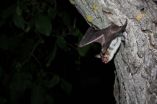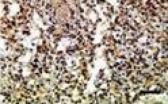(Press-News.org) This news release is available in German.
Animals can use varying sensory modalities for orientation, some of which might be very different from ours. Some bird species for example take the polarization pattern produced by sunlight in the atmosphere to calibrate their orientation systems. Now researchers from the Max Planck Institute for Ornithology in Seewiesen, Germany, and Queen's University Belfast have discovered with colleagues from Israel that a night active mammal, the greater mouse-eared bat, has the capability to orient using polarized light. These bats use the polarization pattern of the evening sky to calibrate their inner compass.
In the course of evolution manifold sensory systems developed which allowed animals varying possibilities to perceive their environment. Many insect species for example, but also some fish, amphibians, reptiles and birds can see polarized light. Polarized light forms as a result of sunlight being scattered in the atmosphere. The sky's polarization pattern can be used by animals as a compass, well-known examples being the orientation of honeybees, desert ants or migratory birds. Even humans can perceive polarized light to some degree. Subject to certain conditions we can see a so called Haidinger's brush, a diffuse yellowish form, which however, has no known function. The fact that mammals can also make use of this sensory perception was not known so far.
An international team of bat researchers including Stefan Greif from the Max Planck Institute for Ornithology, Seewiesen, and from the Queen's University Belfast now found exactly that. Their study shows that the greater mouse-eared bat (Myotis myotis) can use the polarized light of the evening sky to calibrate their orientation system, which is based on the Earth's magnetic field.
The researchers caught 70 female mouse-eared bats in a cave in North-eastern Bulgaria. During dusk they exposed half of the bats to a polarization direction which was shifted 90 degrees from the natural spectrum. The other half of the animals was placed in similar experimental boxes but with a natural polarization direction. Long after nightfall the bats were brought to two different sites some 20 kilometres away from their home roost. There they were released after the scientists equipped them with tiny radio transmitters to follow their flight trajectories on their way back to the cave. Those animals that experienced a 90 degrees shifted polarization pattern at sunset, vanished in a direction which deviated about 90 degrees from the control group. With this simple experiment the researchers showed for the first time that bats can use the polarization pattern of the evening sky to calibrate their inner compass for orientation. The precise mechanism however, is still unknown so far. "Further behavioural and physiological studies are necessary to understand this fascinating new sensory capability", says Stefan Greif, lead author of this study.
INFORMATION:
Original paper:
Stefan Greif, Ivailo Borissov, Yossi Yovel, Richard A. Holland
A functional role of the sky's polarization pattern for orientation in the greater mouse-eared bat
Nature Communications, online publication 22 July 2014 (DOI: http://dx.doi.org/10.1038/ncomms5488)
Bats use the evening sky's polarization pattern for orientation
Max Planck scientists discover new sensory capability in a mammal
2014-07-23
ELSE PRESS RELEASES FROM THIS DATE:
Rising temperatures hinder Indian wheat production
2014-07-23
Geographers at the University of Southampton have found a link between increasing average temperatures in India and a reduction in wheat production.
Researchers Dr John Duncan, Dr Jadu Dash and Professor Pete Atkinson have shown that recent warmer temperatures in the country's major wheat belt are having a negative effect on crop yield. More specifically, they found a rise in nighttime temperatures is having the most impact.
Dr Jadu Dash comments: "Our findings highlight the vulnerability of India's wheat production system to temperature rise, which is predicted to ...
A crystal wedding in the nanocosmos
2014-07-23
Researchers at the Helmholtz-Zentrum Dresden-Rossendorf (HZDR), the Vienna University of Technology and the Maria Curie-Skłodowska University Lublin have succeeded in embedding nearly perfect semiconductor crystals into a silicon nanowire. With this new method of producing hybrid nanowires, very fast and multi-functional processing units can be accommodated on a single chip in the future. The research results will be published in the journal Nano Research.
Nano-optoelectronics are considered the cornerstone of future chip technology, but the research faces major ...
Intestinal parasites are 'old friends,' researchers argue
2014-07-23
Intestinal parasites such as tapeworms, hookworms and a protist called Blastocystis can be beneficial to human health, according to a new paper that argues we should rethink our views of organisms that live off the human body.
To prove the point, paper co-author Julius Lukeš even ingested three developmental stages of a large species of tapeworm called Diphyllobothrium latum. After more than a year with the tapeworms, which might have grown to be as long as four metres each by now, he says he feels fine.
"I knew there was no risk," he says.
Lukeš, a senior fellow ...
Toward an oral therapy for treating Alzheimer's disease: Using a cancer drug
2014-07-23
Currently, no cure exists for Alzheimer's disease, the devastating neurological disease affecting more than 5 million Americans. But scientists are now reporting new progress on a set of compounds, initially developed for cancer treatment, that shows promise as a potential oral therapy for Alzheimer's. Their study appears in ACS' Journal of Medicinal Chemistry.
Carlo Ballatore, Kurt R. Brunden and colleagues explain that in a healthy brain, the protein known as tau binds to and stabilizes microtubules, which are cellular components made of protein inside cells. Microtubules ...
Anti-pain agent shrinks oral cancers, leaves healthy tissues alone
2014-07-23
SAN ANTONIO (July 22, 2014) — Mouse models of human oral cancer treated with an agent called capsazepine showed dramatic tumor shrinkage without damage to surrounding tissues, researchers from the School of Dentistry and School of Medicine at The University of Texas Health Science Center at San Antonio found. The Health Science Center has claimed intellectual property on results of the study, which is described in the journal Oral Oncology.
Late diagnosis, low survival
Oral squamous cell carcinoma is the eighth most common cancer in the U.S. with 40,000 new cases and ...
HIV clinic-based audio project emphasizes the power of patient voices
2014-07-23
(MEMPHIS, Tenn. – July 22, 2014) The voice on the recording was low and calm as the speaker recounted the telephone call that brought the news he was infected with the human immunodeficiency virus (HIV) that causes AIDS: "My heart just stopped for a little bit and next thing you know I was on the floor flat on my face boohooing, crying like a baby."
Yet the message was hopeful when the recording ended less than 10 minutes later. "Don't feel like this is the end of you . . . because it is just God setting you up for something greater," the anonymous speaker tells an unseen ...
Chinese scientists search for evidence of dark matter particles with new underground PandaX detector
2014-07-23
The new PandaX facility, located deep underground in the southwestern Chinese province of Sichuan, hosts a large liquid-xenon detector designed to search for direct evidence of dark matter interactions with the nuclei of xenon and to observe 136Xe double-beta decay.
The detector's central vessel was designed to accommodate a staged target volume increase from an initial 120 kg (stage I) to 0.5 t (stage II) and ultimately to a multi-ton scale.
The technical design of the PandaX facility and detector is outlined in a new paper co-authored by Ji Xiangdong, of the Institute ...
High matrix metalloproteinase-9 expression induces microangiogenesis after cerebral infarction
2014-07-23
Basement membrane degradation and blood-brain barrier damage appear after cerebral infarction, severely impacting neuronal and brain functioning. Matrix metalloproteinase-9 is able to degrade the major components of the basement membrane around cerebral blood vessels and to mediate extracellular matrix remodeling. Therefore, Dr. Huilian Hou and colleagues from the First Affiliated Hospital of Medical School of Xi'an Jiaotong University, China induced cerebral infarction in stroke-prone spontaneously hypertensive rats by intragastric administration of high-sodium water (1.3% ...
Ischemic preconditioning for cerebral infarction: Is it related to upregulation of VEGF?
2014-07-23
Neuroprotection by ischemic preconditioning has been confirmed by many studies, but the precise mechanism remains unclear. In a study released in the Neural Regeneration Research (Vol. 9, No. 11, 2014), Dr. Yong Liu and co-workers from Tongji Hospital Affiliated to Tongji Medical College, Huazhong University of Science and Technology, China performed cerebral ischemic preconditioning in rats by simulating a transient ischemic attack, and explored the mechanism underlying the neuroprotective effect of ischemic preconditioning. Researchers discovered that the infarct volume ...
UNH NHAES researchers work to save endangered New England cottontail
2014-07-23
Scientists with the NH Agricultural Experiment Station are working to restore New Hampshire and Maine's only native rabbit after new research based on genetic monitoring has found that in the last decade, cottontail populations in northern New England have become more isolated and seen a 50 percent contraction of their range.
The endangered New England cottontail is now is at risk of becoming extinct in the region, according to NH Agricultural Experiment Station researchers at the University of New Hampshire College of Life Sciences and Agriculture who believe that restoring ...
LAST 30 PRESS RELEASES:
An earthquake on a chip: New tech could make smartphones smaller, faster
New research shows how AI tools are expanding individual capabilities while contracting scientific attention
A nanomaterial flex — MXene electrodes help OLED display technology shine, while bending and stretching
Global research team uncovers mechanism by which metabolites guide cellular decisions
Work hours, stress, and burnout among resident physicians
Quality of life of parents of premature infants
Should younger and older people receive different treatments for the same infection?
Scientists discover how fast the world’s deltas are sinking
Scientists demonstrate first-time use of AI for genetic circuit design
Copenhagen researchers make the front page of Nature: Solving the mystery of the universe's ‘little red dots’
Seoul National University-Drexel University team achieves world's highest efficiency fully stretchable OLEDs with 17% external quantum efficiency
Hydrogel cilia set new standard in microrobotics
Application of orthogonal CNOP-I in a convection-allowing ensemble prediction system based on CMA-MESO for improving extreme precipitation skill
Study suggests bamboo has ‘superfood’ potential
Hidden heart-care gaps among Asian American patients
Blood test predicts which patients with lung cancer will benefit from newly approved immunotherapy drug
SwRI’s Dr. Michael Davis named SPIE Fellow
Exposure to “forever chemicals” linked to higher risk of gestational diabetes, major review finds
Insilico Medicine integrates Nach01 Foundation Model with Microsoft Discovery to enable AI-native, enterprise-ready drug discovery workflows
New study reveals precursors for forecasting summer clustered extreme precipitation events in Northeast China
A bacterial toxin can counteract colorectal cancer growth
Frozen hydrogen cyanide ‘cobwebs’ offer clues to origin of life
Physics of foam strangely resembles AI training
Bis-pseudoindoxyls: a new class of single benzene-based fluorophores for bioimaging applications
Blocking a cancer-related pathway helps reduce spine deformities due to genetic disorder, finds new study
New study explores therapeutic potential of CRISPRCas3 genome-editing system
Korea University researchers revive an abandoned depression drug target using structurally novel NK1 receptor inhibitors
Jeonbuk National University researchers highlight advancements in chemical looping fluidized bed reactors
Tyrannosaurus rex grew up slowly: New study reveals the “king of dinosaurs” kept growing until age 40
Commercial water dispenser machines may contain more contamination than tap water
[Press-News.org] Bats use the evening sky's polarization pattern for orientationMax Planck scientists discover new sensory capability in a mammal






